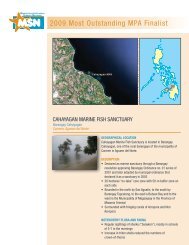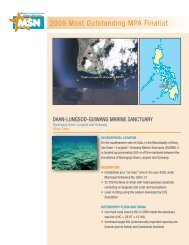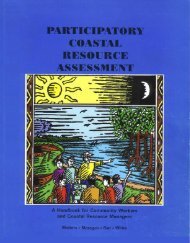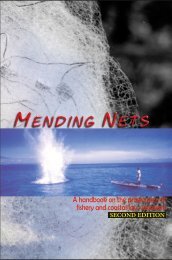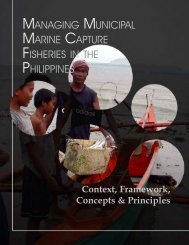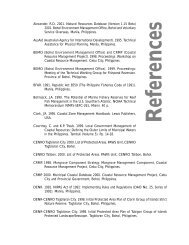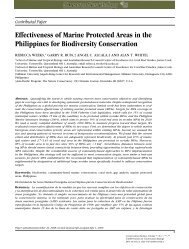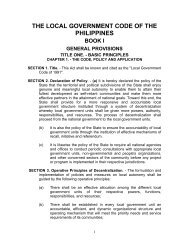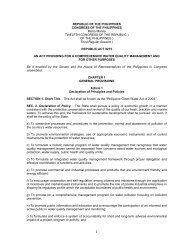3.9MB / Click here to download - Oneocean.org
3.9MB / Click here to download - Oneocean.org
3.9MB / Click here to download - Oneocean.org
Create successful ePaper yourself
Turn your PDF publications into a flip-book with our unique Google optimized e-Paper software.
18 Rhythm of the Sea<br />
Open<br />
Water<br />
ters<br />
Plank<strong>to</strong>n composition of open waters off the area is dominated by zooplank<strong>to</strong>n (62.28<br />
percent). The zooplank<strong>to</strong>n community consists of tintinnids, nauplii, copepods, larvaceans,<br />
gastropods and bivalves. Other groups include dia<strong>to</strong>ms (31.35 percent), dinoflagellates<br />
(7.13 percent) and other algae (0.24 percent).<br />
The phy<strong>to</strong>plank<strong>to</strong>n community is mainly made up of dia<strong>to</strong>ms, blue-green algae and<br />
dinoflagellates. The dia<strong>to</strong>ms are composed of 58 species, of which Coscinodiscus,<br />
Rhizosolenia and Thalassionema are the most abundant. A blue-green algae, Trichodesmium,<br />
is also common in the area.<br />
Forty-seven species of dinoflagellates belonging <strong>to</strong> 20 genera are present. These<br />
include some species known <strong>to</strong> be <strong>to</strong>xic in causing red tide such as: Alexandrium, Ceratium,<br />
Dinophysis, Gambierdiscus, Gonyaulax, Noctiluca, Peridinium, Pro<strong>to</strong>peridinium and<br />
Pyrodinium. These <strong>to</strong>xic algae are potentially detrimental <strong>to</strong> human health when they<br />
affect bivalves and other marine <strong>org</strong>anisms commonly eaten (SUML 1997).<br />
While most of the identified dinoflagellate species are not <strong>to</strong>xic, their potential<br />
blooms can result in the lowering of water quality. Even a non-<strong>to</strong>xic bloom still results in an<br />
enormous amount of <strong>org</strong>anic matter decomposing in the water. Large amounts of <strong>org</strong>anic<br />
matter decomposition can cause anoxia (deoxygenation) due <strong>to</strong> high biochemical oxygen<br />
demand by the decomposing life forms. Once the level of dissolved oxygen drops below 5<br />
mg/L, fish and other marine species become stressed and may die. The blooms also increase<br />
the ammonia level (a by-product of decomposition) in the water. Such algal blooms are<br />
sometimes triggered by increased sediment or nutrient loads from shoreline run off.<br />
Corals<br />
Except for those in Danajon Bank, the majority of the coral reefs of northwestern Bohol are<br />
fringing reefs with widths from 100 <strong>to</strong> 200 m. Substrate composition is defined by rubble,<br />
sand and rock, while seagrasses flourish at the shallower portion of the reefs. One hundred<br />
twelve identified species of scleractinian corals belonging <strong>to</strong> 14 families abound in the<br />
municipal waters of the profile area. Eleven species of non-scleractinian and certain soft<br />
corals are also present in limited areas (SUML 1997). T<strong>here</strong> are large areas that have not<br />
yet been sampled.<br />
Through random quadrat surveys in selected sites, a mean live hard coral (LHC)<br />
cover of 31.35 percent has been determined. Rating the coral habitat in profile area waters,<br />
one would have <strong>to</strong> give it an overall rating of fair <strong>to</strong> poor only.<br />
High LHC cover can be found in Inabanga (58.75 percent; good condition) and<br />
Tubigon (40 percent; fair condition). The lowest values are in Buenavista and Calape (15.3



